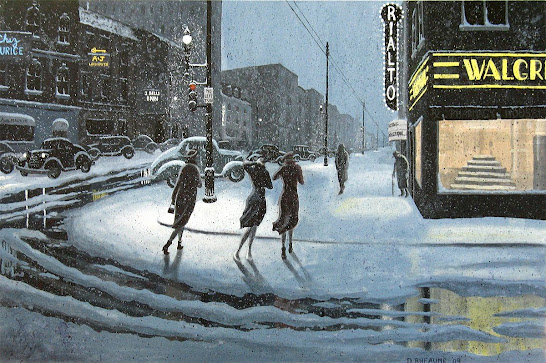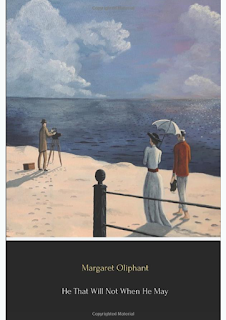Stormy Weather
"Caught by the Storm" 2009
I painted the above painting a few years ago, and, as quintessentially Canadian a scene as it seems to be, it is in fact a depiction of Raleigh, North Carolina in the 1930s. The Walgreen's storefront is something of a clue in that regard.
Much of my work is researching archival images. Typically what I'll do is enter a Google search like "Winter Night 1930" and see what comes up. This one from Raleigh stopped me in my tracks, for reasons that would be obvious to anyone who follows my work. It's of a freak snowstorm that hit the city in 1936.
I'm often asked at art shows whether my paintings are based on photographs, and the answer is that it's a mix. Some of them are more or less faithful reproductions. A lot of them are completely invented scenes, but I'll use photos as a reference for what an old car, wagon or lamppost looks like. But the usual scenario is "reproduction with embellishments", which is the case here. I also think it's important to alter the scenes simply as a way of putting my own creative stamp on a painting...and as such would never want to merely slavishly duplicate what was in the photos. There are rare occasions when straying from dead historical accuracy causes consternation in an old timer at one of my shows, but I look upon that simply as an occupational hazard.
The first and most obvious of my alterations to an archival pic is the addition of colour (note to anyone thinking of working with visuals of any form...a good working knowledge of imaging programs like Photoshop is worth its weight in gold). I thought the mood and atmosphere of the above picture was fantastic to begin with, and I sensed that the original scene was taken as evening approached. I thought that effect could be enhanced by pushing the scene a little further into the night. This would involve a palette more in the blues, which would in turn be a stronger contrast to the various lights sources which would not only be brighter, but more on the warm colour scale. I tested out the effect of that by tinting the picture in Photoshop:
Pushing the timeframe towards night also impacted how the lighting would play. The Walgreen's marque was already prominent, as was the red stop light and car headlights. But the street lamps, off in the original, could also now be lit up and would provide the all-important pool of light against which the main figures would contrast. Lighting opportunities are something that I look for in a reference picture, and I often turn day to night simply because of their existence. Another subtle change to augment the lighting was to imagine a slightly warmer night for the painting, so that the falling snow was melting on the streets and providing an opportunity to reflect the various light sources down onto the asphalt.
Lastly there's the changes to the compositional elements. The most obvious of those was the removal of the fourth woman in the group. Three is generally a cleaner number to deal with in most artistic endeavours. In fact it's almost a standard. Trimming it down to a trio also helped to emphasize their flowing, wispy forms...something that attracted me to the picture to begin with. I elongated them slightly as well to add to the effect, and that manner of treating human forms would become something of a hallmark of my paintings. I improvised my own buildings and signs on the left side of frame, and lastly, added the "Rialto" theatre marque on the right side (an homage to my childhood in Ottawa...let's see the old timers try to sort THAT out).
Finally, I titled the piece "Caught by the Storm" because I sensed that based on their attire and their posture, the ladies seemed somewhat unprepared for the severity of this icy arctic blast.







Comments
Post a Comment